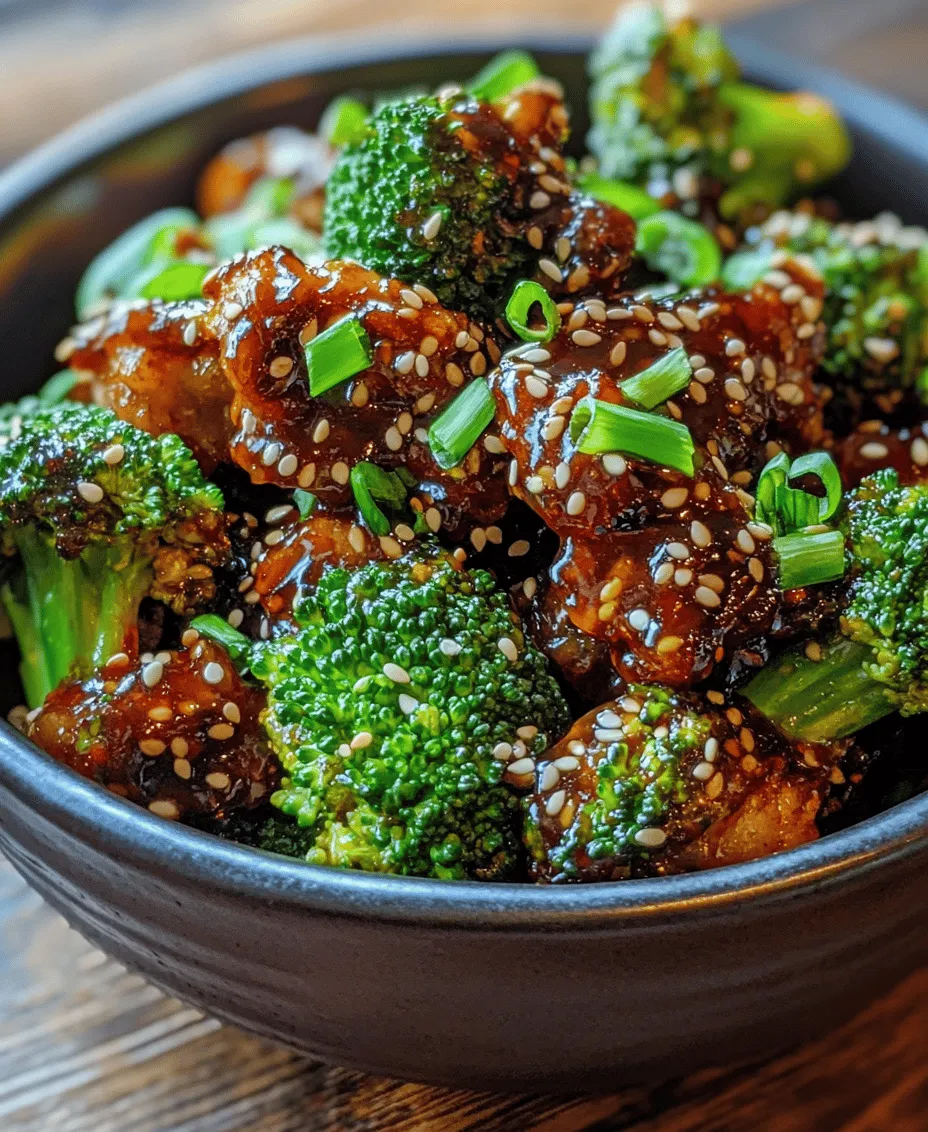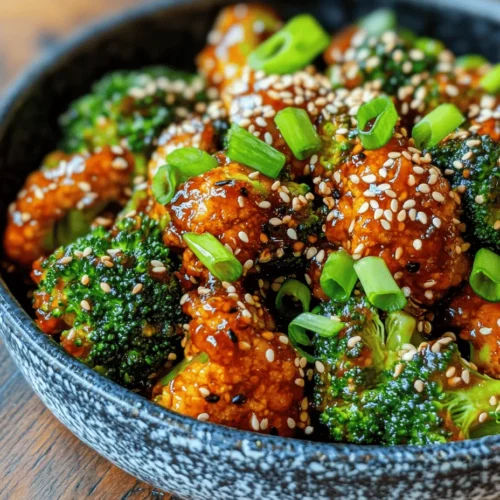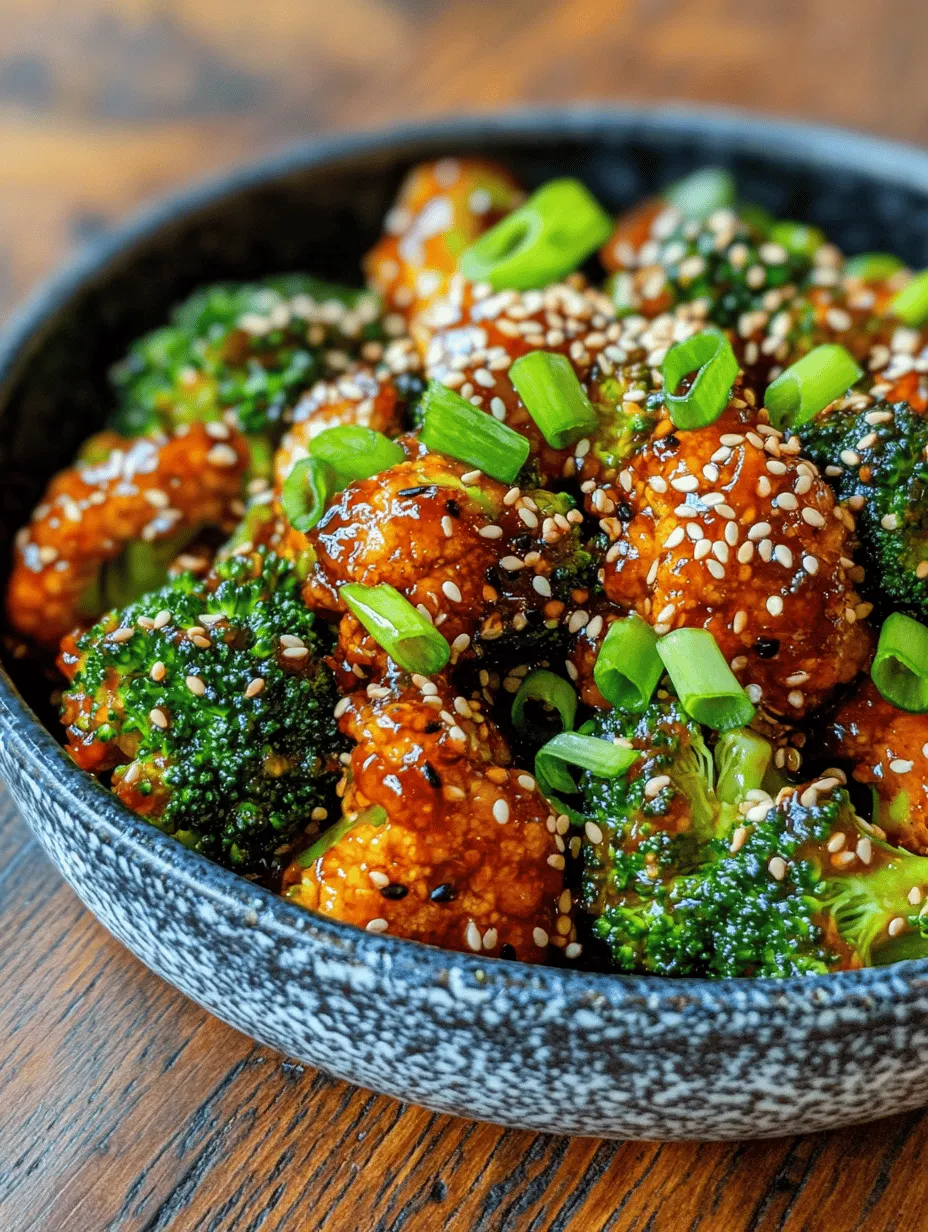Introduction to Broccoli Bliss: Easy Gochujang Delight
In the ever-evolving world of culinary delights, few dishes can boast the balance of flavor, nutrition, and simplicity quite like Broccoli Bliss: Easy Gochujang Delight. This recipe showcases the vibrant green vegetable, broccoli, transformed into a sumptuous dish with a kick of gochujang, a traditional Korean chili paste. As more people explore the benefits of incorporating plant-based ingredients into their diets, this dish stands out not only for its taste but also for its health benefits, making it a perfect addition to any meal.
The appeal of Broccoli Bliss lies in its harmonious blend of flavors and textures. The earthy, slightly bitter notes of broccoli are elevated by the rich, spicy sweetness of gochujang, creating a unique and satisfying experience for the palate. Whether enjoyed as a side dish or a main course, this recipe caters to a variety of dietary preferences, making it a versatile option for anyone looking to add a nutritious twist to their meals.
At the heart of this dish is gochujang, a staple in Korean cuisine that has gained popularity worldwide. Known for its robust flavor profile, it serves as a key ingredient that not only enhances the dish’s taste but also adds depth and complexity. In this article, we will delve into the magic of gochujang and explore the health benefits of broccoli, providing you with an understanding of why Broccoli Bliss is a dish worth trying.
Understanding the Magic of Gochujang
Definition and History of Gochujang
Gochujang is a fermented chili paste that has been a cornerstone of Korean cooking for centuries. Its roots can be traced back to the 16th century when it was created as a way to preserve food and enhance its flavor. Made from a blend of red chili powder, glutinous rice, fermented soybeans, and salt, gochujang is known for its thick, sticky texture and deep red color. Over time, it has become an essential ingredient in numerous Korean dishes, from stews to marinades, and is celebrated for its unique ability to balance sweetness, spiciness, and umami.
The fermentation process not only contributes to gochujang’s distinctive flavor but also enhances its nutritional profile. This traditional ingredient has recently gained a following in global cuisine, with chefs and home cooks alike incorporating it into various recipes, from soups to salad dressings, to give dishes an unforgettable kick.
Nutritional Profile of Gochujang
Gochujang is not just a flavor enhancer; it also packs a nutritional punch. A typical serving contains a modest amount of calories, making it a guilt-free option for those looking to spice up their meals without adding excessive calories. It is rich in antioxidants due to the presence of chili peppers, which are known for their anti-inflammatory properties. Moreover, the fermentation process involved in making gochujang introduces beneficial probiotics, which can support gut health and enhance digestion.
In addition to these benefits, gochujang is often lower in sodium compared to other condiments, making it a healthier choice for flavoring dishes. Its ability to add depth without the need for excessive salt makes it a great option for those monitoring their sodium intake.
How Gochujang Enhances Flavors in Dishes
One of the most compelling aspects of gochujang is its versatility. The heat from the chili peppers is balanced by a natural sweetness, which allows it to complement a wide range of ingredients. When used in cooking, gochujang can elevate the flavors of vegetables, meats, and grains, creating a well-rounded dish that excites the taste buds.
In Broccoli Bliss, the gochujang sauce coats the broccoli, infusing it with a rich flavor that contrasts beautifully with its natural earthiness. This dish exemplifies how the right ingredients can come together to create something truly special, showcasing the magic of gochujang in a simple, accessible way.
Broccoli: A Nutritional Powerhouse
Overview of Broccoli’s Health Benefits
Broccoli is often hailed as a superfood, and for good reason. This cruciferous vegetable is not only low in calories but also high in essential nutrients, making it an excellent choice for those looking to maintain a healthy diet. Its impressive nutritional profile includes high levels of vitamins C and K, fiber, and a variety of antioxidants that contribute to overall health.
Eating broccoli has been linked to numerous health benefits, including improved digestion, reduced inflammation, and a lower risk of chronic diseases such as heart disease and certain types of cancer. The high fiber content in broccoli aids in digestion, promoting a healthy gut and contributing to a feeling of fullness, which can help with weight management.
Key Vitamins and Minerals Found in Broccoli
Broccoli is particularly rich in vitamin C, which plays a crucial role in boosting the immune system, promoting skin health, and aiding in the absorption of iron. Vitamin K is another standout nutrient, essential for blood clotting and bone health. Additionally, broccoli contains folate, potassium, and a range of B vitamins that support cellular function and overall well-being.
The antioxidants present in broccoli, such as sulforaphane, have been shown to have anti-cancer properties, making this vegetable a wise choice for those looking to enhance their health through diet. By incorporating broccoli into your meals, you not only enjoy its delicious flavor but also reap the numerous benefits it offers.
Broccoli’s Role in a Balanced Diet
Incorporating broccoli into a balanced diet is easy and rewarding. Its versatility allows it to be used in a variety of dishes, from stir-fries to soups, salads, and even smoothies. Eating a diverse range of vegetables, including broccoli, is key to obtaining the necessary nutrients for optimal health.
For those following a vegetarian or vegan diet, broccoli serves as an excellent source of plant-based protein, especially when combined with other ingredients like legumes or grains. The combination of flavors and textures in Broccoli Bliss makes it an ideal dish to incorporate into any meal plan, providing both satisfaction and nourishment.
Ingredients Breakdown for Broccoli Bliss
To create Broccoli Bliss: Easy Gochujang Delight, you’ll need a few essential ingredients. Each one plays a vital role in building the dish’s flavor and nutritional profile. Here’s a detailed breakdown:
Fresh Broccoli
The star of the dish, fresh broccoli, should be firm and vibrant green. When selecting broccoli, look for tightly closed florets and crisp stems. Fresh broccoli not only offers the best flavor but also retains its nutritional benefits. If you cannot find fresh broccoli, frozen can be a suitable alternative; just be sure to thaw and drain it before use.
Gochujang
As the key ingredient, gochujang brings its signature spice and sweetness to the dish. Available in various heat levels, you can choose the one that best suits your palate. For those unfamiliar with gochujang, it can typically be found in the international section of grocery stores or in specialty Asian markets. If you’re in a pinch, you might consider homemade alternatives using chili paste mixed with sugar and soy sauce, though the flavor won’t be identical to the original.
Soy Sauce
Soy sauce adds depth and umami to the dish. It enhances the savory notes and complements the sweetness of the gochujang. For a gluten-free version, tamari can be used as a substitute without compromising flavor.
Sesame Oil
Sesame oil contributes a rich, nutty aroma that elevates the overall taste of Broccoli Bliss. It’s best to use toasted sesame oil for its enhanced flavor. If you prefer a different taste, you can opt for olive oil, though it will alter the traditional flavor profile of the dish.
Garlic
Fresh garlic lends a pungent, aromatic quality that beautifully balances the dish. It’s recommended to use minced garlic for a stronger flavor. If you’re in a hurry, garlic powder can serve as a substitute, but the fresh version is always preferable for its vibrant taste.
Optional Add-Ins
Depending on your preference, you might want to consider additional ingredients like sesame seeds for garnish, scallions for a fresh crunch, or toasted nuts for added texture. These optional add-ins can enhance the presentation and flavor of the dish, making it even more delightful.
Suggestions for Ingredient Substitutions
For those with dietary restrictions or preferences, there are plenty of ways to customize the ingredients. For example, you can use tamari instead of soy sauce for a gluten-free option. If you’re looking for a vegan alternative, ensure that your gochujang and soy sauce are free from animal products. Additionally, you can modify the recipe to include other vegetables like bell peppers, snap peas, or carrots for a colorful and nutritious twist.
Step-by-Step Guide to Making Broccoli Bliss
Now that we’ve covered the ingredients, it’s time to dive into the preparation of Broccoli Bliss: Easy Gochujang Delight. Follow these detailed steps to create a dish that’s sure to impress:
Preparation of the Sauce
1. Gather Ingredients: Start by measuring out the gochujang, soy sauce, and sesame oil in a small bowl. For added depth, include minced garlic and any optional ingredients you desire.
2. Mix the Sauce: Whisk together the ingredients until they form a smooth, well-combined sauce. Adjust the levels of gochujang according to your preferred spice level. If you prefer a sweeter sauce, consider adding a teaspoon of honey or maple syrup.
Detailed Instructions for Combining Ingredients
1. Prepare the Broccoli: Begin by washing the broccoli thoroughly under running water. Trim the ends of the stems and cut the florets into bite-sized pieces. This will help ensure even cooking.
2. Blanch the Broccoli: In a large pot, bring water to a boil. Once boiling, add the broccoli and blanch for about 2-3 minutes until bright green and slightly tender. This step helps to preserve the vibrant color and nutrients. After blanching, immediately transfer the broccoli to an ice bath to stop the cooking process. Drain and set aside.
3. Cook the Sauce: In a skillet over medium heat, add a drizzle of sesame oil. Once heated, pour in the prepared sauce and let it simmer for a minute, allowing the flavors to meld together.
4. Combine the Broccoli and Sauce: Add the blanched broccoli to the skillet, tossing it gently in the sauce to ensure an even coating. Cook for an additional 2-3 minutes, allowing the broccoli to absorb the flavors from the sauce.
5. Serve: Once everything is heated through, remove the skillet from the heat. Garnish with optional sesame seeds or sliced scallions for an added touch of flavor and presentation.
With these steps, you’ll have a delicious and nutritious dish ready to serve, showcasing the wonderful flavors of broccoli and gochujang. Enjoy!

Tips for Achieving the Perfect Consistency of the Sauce
The sauce is the heart of the Broccoli Bliss recipe, and achieving the right consistency is crucial for a delightful dining experience. Here are some tips to ensure your gochujang sauce has the perfect texture:
1. Start with a Base: Begin with a base of soy sauce or tamari for a gluten-free option. This provides a liquid foundation that helps the gochujang blend smoothly.
2. Add a Sweetener: Incorporating a sweetener, such as honey or maple syrup, not only balances the spice of the gochujang but also contributes to a thicker consistency. Add this gradually until you reach your desired sweetness.
3. Incorporate an Acid: A splash of rice vinegar or lime juice helps brighten the flavors of the sauce while also aiding in achieving a silky texture. This is particularly important if the sauce feels too thick.
4. Adjust with Water or Broth: If the sauce is too thick, you can thin it out with a little water or vegetable broth. Add it a tablespoon at a time until you get the desired consistency.
5. Whisk Away: Use a whisk or a fork to thoroughly combine all ingredients. This ensures that the sauce is smooth and well-integrated. If you prefer a creamier texture, consider blending the sauce in a small food processor.
Steaming the Broccoli
Steaming broccoli is a simple yet effective cooking method that preserves its vibrant color, crunch, and nutritional benefits. Here’s how to steam your broccoli properly:
Explanation of the Steaming Process and Its Benefits
Steaming broccoli involves cooking it with steam rather than submerging it in boiling water. This method retains more nutrients compared to boiling, as fewer vitamins and minerals leach out. Additionally, steaming helps maintain the broccoli’s bright green hue and crisp texture, making it more visually appealing.
Visual Cues for Knowing When Broccoli is Done
Perfectly steamed broccoli should be bright green and tender but still slightly crisp. Here are some visual cues to help you know when it’s done:
– Color: Look for a vibrant green color. If the broccoli starts to look dull or olive green, it’s overcooked.
– Texture: The florets should be tender enough to pierce with a fork but still firm. If they fall apart easily, you’ve gone too far.
– Time: Generally, broccoli takes about 5-7 minutes to steam. Check it at the 5-minute mark to avoid overcooking.
Combining and Serving
Once your broccoli is perfectly steamed, it’s time to combine it with the gochujang sauce for an explosion of flavor.
Step-by-Step Instructions on How to Coat the Broccoli with the Sauce
1. Prepare the Sauce: Make sure your gochujang sauce is ready and at the right consistency. If necessary, warm it slightly on the stove to make it easier to coat the broccoli.
2. Combine: Place the steamed broccoli in a large mixing bowl. Drizzle the gochujang sauce over the broccoli, starting with half, and gently toss using tongs or a spatula.
3. Coat Evenly: Add more sauce as needed, ensuring all the broccoli florets are evenly coated. Be careful not to overdo it on the sauce; you want to enhance the broccoli’s flavor, not overwhelm it.
4. Taste and Adjust: Before serving, taste a piece of broccoli. If you feel it needs more flavor, add a bit more sauce or a sprinkle of sesame seeds for added texture.
Creative Serving Suggestions for Presentation
To elevate your Broccoli Bliss dish, consider these presentation ideas:
– Plating: Serve the coated broccoli on a large platter. For a pop of color, garnish it with sliced red chili peppers or chopped scallions.
– Serving Bowls: Use small, individual serving bowls for a more intimate dining experience. This is especially appealing for gatherings or family dinners.
– Accompaniments: Pair the broccoli with a side of jasmine rice or quinoa for a complete meal. Arrange the rice on the side, and place the broccoli on top for a visually appealing contrast.
Flavor Pairings and Serving Suggestions
Broccoli Bliss is incredibly versatile and can be paired with various dishes to create a balanced meal.
Ideas for Pairing with Main Dishes
– Rice: Serve the broccoli over a bed of steamed jasmine or brown rice. The grains absorb the flavors of the gochujang sauce, making each bite delicious.
– Grilled Chicken or Tofu: This dish pairs well with protein. Grilled chicken enhances the meal’s heartiness, while tofu provides a plant-based option that complements the spicy sauce beautifully.
– Noodle Dishes: Consider tossing the broccoli into a bowl of ramen or stir-fried noodles for a delightful twist.
Suggestions for Serving as a Snack or Appetizer
Broccoli Bliss can also shine as a snack or appetizer:
– Dipping Sauce: Serve the broccoli with a side of the gochujang sauce for dipping. This encourages a fun, interactive eating experience.
– Finger Food: Create bite-sized portions for easy snacking. Guests will love grabbing pieces of broccoli coated in the spicy, savory sauce.
How to Incorporate This Dish into Meal Prep
Broccoli Bliss is perfect for meal prep:
– Batch Cooking: Prepare a larger quantity of broccoli and sauce, and store them separately in airtight containers. This allows you to grab a quick serving throughout the week.
– Versatile Add-Ins: Mix and match with various proteins and grains to keep your meals exciting. For example, pair with different proteins each day or serve over roasted sweet potatoes one day and noodles the next.
The Versatility of Broccoli Bliss
This recipe is not only simple to prepare but also adaptable to various dietary preferences and culinary styles.
Exploring Variations of the Recipe
– Add Protein: For a more filling dish, consider adding cooked shrimp, chicken, or chickpeas. Simply toss the protein with the broccoli and sauce before serving.
– Different Vegetables: Mix in other vegetables like bell peppers, snap peas, or carrots to create a colorful medley. Each vegetable adds its unique flavor and texture.
Adapting the Recipe for Different Dietary Preferences
– Gluten-Free: Ensure your soy sauce is gluten-free by using tamari or coconut aminos. This simple swap makes the dish accessible to those with gluten sensitivities.
– Vegan: Substitute honey with maple syrup or agave nectar to keep the dish entirely plant-based.
Ideas for Using Leftover Broccoli or Sauce
If you find yourself with leftover broccoli or sauce, here are some creative ways to repurpose them:
– Fried Rice: Toss leftover broccoli into a stir-fry or fried rice dish for added flavor and nutrition.
– Wraps: Incorporate the broccoli into wraps with hummus, lettuce, and other veggies for a quick lunch option.
– Sauce Uses: The gochujang sauce can be used as a marinade or dressing for salads, giving your meals an exciting kick.
Conclusion: Embracing Flavor and Nutrition with Broccoli Bliss
Broccoli Bliss is more than just a side dish; it’s an exciting exploration of flavors and textures that highlights the versatility of broccoli. With its spicy gochujang sauce, this dish not only tantalizes your taste buds but also packs a nutritional punch, making it a perfect addition to any meal.
As you experiment with gochujang in this recipe, consider how it could enhance other dishes in your culinary repertoire. The joy of cooking lies in the ability to explore and innovate, and this recipe serves as a wonderful foundation for that journey. Embrace the joy of healthy eating and let Broccoli Bliss inspire you to create meals that are both delicious and nutritious.


